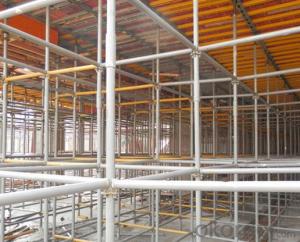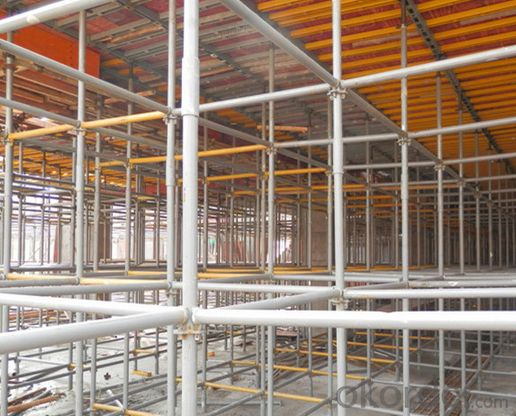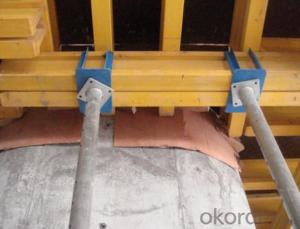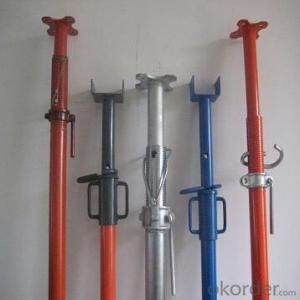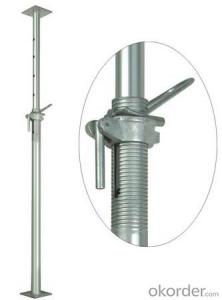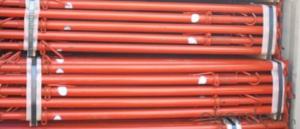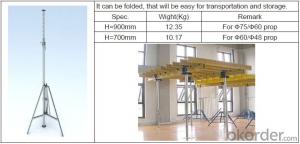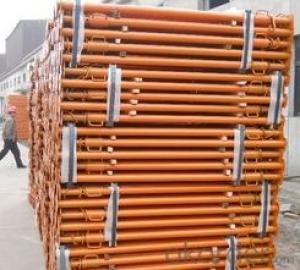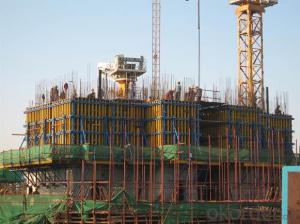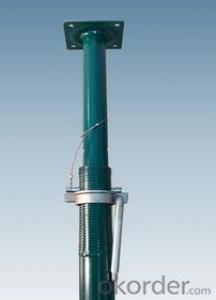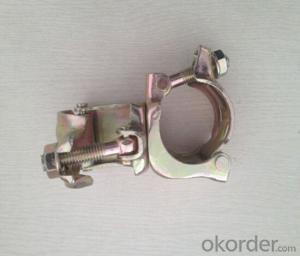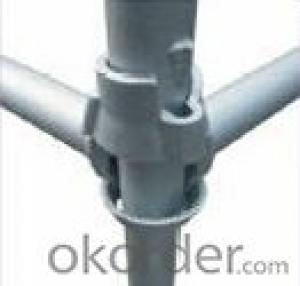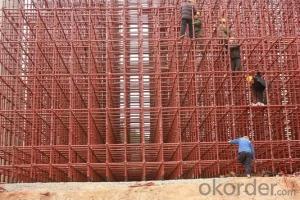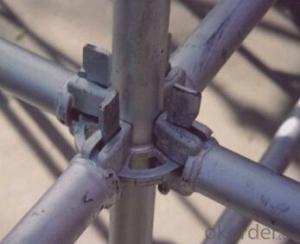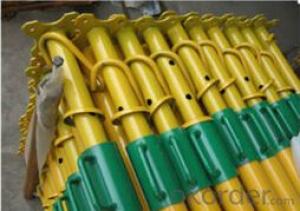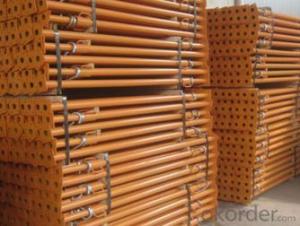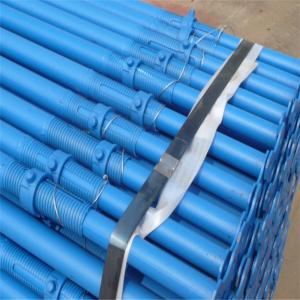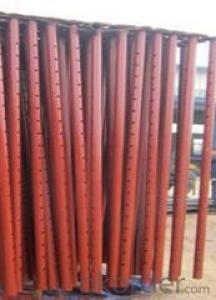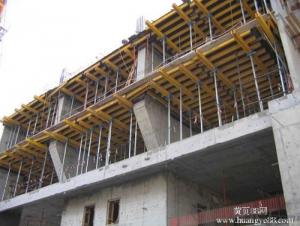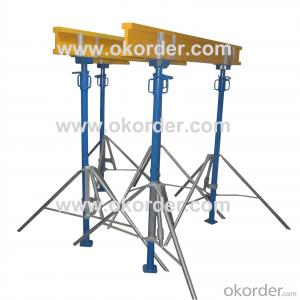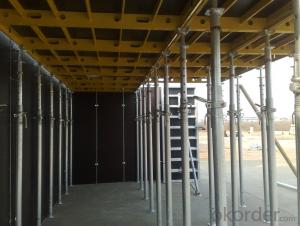Scaffolding for slab, quick locking plate scaffolding, steel scaffolding for construction
- Loading Port:
- China Main Port
- Payment Terms:
- TT OR LC
- Min Order Qty:
- -
- Supply Capability:
- -
OKorder Service Pledge
OKorder Financial Service
You Might Also Like
Quick Details
| Material: | Certificate: | Surface treatment: | |||
| Color: |
Packaging & Delivery
| Packaging Detail: | according to customers' request |
| Delivery Detail: | 10-20 days |
Specifications
1.Raw material:Q235 cold rolled steel
2.Easy to install and dismantle
3.High efficiency
4.Timely delivery
1. Quick Info
a. Model: Slab Formwork (pure steel, electrophoretic coated)
b. Application: used together with plywood for concrete form.
d. Load Capacity: 3 to 4 tons per s.q.m.(whole system)
e. Installation: A group of 4 workers can erect 300s.q.m in 8 hours.
Feature
* For heavy loads upto 2m thickness slab
* For high shoring like fly over roads and working platform around tower
* Maximizing the usage of materials for different projects easily due to various sizes of cross bracing
* Can be moved by trolley or crane, even with whole large unit - once assembled, whole phase application without repeated dismantiling and assembly.
* Key role in slab flex and slab table formwork
- Q: How do steel props contribute to the prevention of concrete slab deflection?
- Steel props are vertical supports that are commonly used in construction to provide temporary support and stability to concrete slabs during the curing process. These props play a crucial role in preventing concrete slab deflection. Firstly, steel props provide additional structural support to the concrete slab, especially in areas where the concrete is still setting and has not gained its full strength. This prevents the slab from sagging or deflecting under its own weight, ensuring that it remains level and in the desired position. Moreover, steel props are adjustable in height, allowing construction workers to raise or lower them as needed to maintain the desired level of the concrete slab. This adjustability helps to counteract any potential deflection caused by uneven ground or substandard support. Furthermore, steel props distribute the load evenly across the concrete slab, minimizing stress concentrations that could lead to deflection. By supporting the slab at multiple points, the props help to evenly distribute the weight and prevent any localized areas of excessive load, which can cause deflection. In addition, steel props provide stability and prevent lateral movement of the concrete slab. This is particularly important during the curing process when the concrete is still vulnerable to shifting or settling. The props help to keep the slab in place and ensure that it sets properly without any significant deflection. Overall, steel props are essential in preventing concrete slab deflection by providing additional support, adjustability, load distribution, and stability. Their use during the construction process ensures that the slab remains level, structurally sound, and meets the required standards for deflection control.
- Q: How do steel props accommodate for changes in temperature and weather conditions?
- Steel props, also known as adjustable steel props or acrow props, are a versatile and reliable tool used in construction to support temporary structures or to provide additional support during construction or renovation work. When it comes to accommodating changes in temperature and weather conditions, steel props are designed to withstand and adapt to these variations. One way steel props accommodate for changes in temperature is through their material strength and durability. Steel is known for its high strength-to-weight ratio, making it resistant to deformation or structural failure caused by temperature fluctuations. Whether it's extreme cold or hot weather, steel props can maintain their structural integrity and effectively support the load they are intended to bear. In addition to their material properties, steel props can be adjusted to accommodate for changes in temperature and weather conditions. These props typically consist of an inner tube and an outer tube that can be extended or retracted to adjust the overall height. This adjustability allows the props to compensate for any expansion or contraction that may occur due to temperature changes. By simply adjusting the height of the prop, construction workers can ensure that the temporary structure or load remains properly supported regardless of temperature fluctuations. Furthermore, steel props are often coated with protective finishes or coatings to enhance their resistance to corrosion caused by weather conditions such as rain, humidity, or exposure to saltwater. These protective coatings provide an additional layer of defense against rust and deterioration, ensuring that the steel props can withstand different weather conditions over an extended period. Overall, steel props are designed to be sturdy, adaptable, and resilient, making them well-suited for accommodating changes in temperature and weather conditions. Their material strength, adjustability, and protective coatings enable them to withstand the challenges brought by varying weather conditions, ensuring the safety and stability of temporary structures or loads during construction or renovation projects.
- Q: How do steel props compare to hydraulic jacks?
- Steel props and hydraulic jacks are both commonly used for temporary support in construction projects, but they have some key differences. Steel props are typically made of strong steel tubes and are manually adjusted to provide support. They are easy to install and can be adjusted to the desired height. However, they may require more labor and time to set up and adjust. On the other hand, hydraulic jacks are powered by hydraulic pressure, making them easier and quicker to set up and adjust. They also have a higher load-bearing capacity compared to steel props. However, hydraulic jacks are generally more expensive and require skilled operators. Overall, the choice between steel props and hydraulic jacks depends on the specific requirements of the project, the load-bearing capacity needed, and the available budget and resources.
- Q: What are the advantages of using steel props over traditional wooden supports?
- There are several advantages of using steel props over traditional wooden supports. Firstly, steel props offer greater strength and durability compared to wooden supports, making them more reliable and long-lasting. Secondly, steel props are adjustable, allowing for easy customization and adaptability to different heights and load-bearing requirements. Additionally, steel props are non-combustible, providing enhanced safety in situations where fire hazards are a concern. Lastly, steel props are lightweight and easy to handle, simplifying the transportation and installation process.
- Q: Are there any specific regulations or standards that govern the use of steel props?
- Yes, there are specific regulations and standards that govern the use of steel props. These regulations and standards are in place to ensure the safety and structural integrity of structures being supported by steel props. In many countries, the use of steel props is covered by building codes and regulations that dictate the minimum requirements for their design, installation, and usage. For example, in the United States, the Occupational Safety and Health Administration (OSHA) provides regulations and guidelines under the Construction Industry Safety and Health Standards (29 CFR 1926) that address the use of steel props as temporary supports. These regulations outline requirements for the design, installation, inspection, and removal of steel props to prevent accidents and protect workers. Furthermore, various organizations and standards bodies have developed specific standards and guidelines for the use of steel props. One such example is the British Standard BS 4074, which provides guidelines for the design, construction, and use of adjustable steel props in temporary support structures. These regulations and standards typically cover aspects such as load capacities, maximum heights, spacing requirements, bracing, stability, and safe working practices. They also often require proper documentation, including instructions for use, maintenance records, and regular inspections. It is essential for construction professionals, contractors, and workers involved in the use of steel props to be familiar with these regulations and standards and ensure compliance to ensure the safety of personnel and the structural stability of supported structures.
- Q: Can steel props be used for supporting temporary scaffolds during maintenance?
- Indeed, steel props have the capability to offer support for temporary scaffolds during maintenance tasks. Referred to as steel acrow props or adjustable steel props, these props are frequently utilized in construction and maintenance ventures to provide transitory support. Their height can be adjusted, making them suitable for a variety of applications, including scaffold support. Made from top-notch steel, these props guarantee a robust and stable support system, ensuring the safety and stability of the scaffold throughout maintenance operations. Furthermore, steel props are effortless to both assemble and disassemble, rendering them a convenient option for temporary scaffolding requirements.
- Q: Can steel props be used in different weather conditions?
- Yes, steel props can be used in different weather conditions. Steel is a strong and durable material that can withstand various weather conditions such as rain, wind, and extreme temperatures. However, it is important to ensure proper maintenance and protection to prevent rust and corrosion that can be caused by prolonged exposure to harsh weather elements.
- Q: How do steel props prevent structural collapse during construction?
- During construction, steel props, also referred to as adjustable steel props or acrow props, play a vital role in averting structural collapse. These temporary supports are extensively utilized in the construction industry to reinforce structures and maintain stability at different stages of the building process. One of the primary functions of steel props is to evenly distribute the weight load of the structure to the ground. In construction sites, load-bearing walls or columns are often removed or modified, which can compromise the overall stability of the structure. To prevent collapse, steel props are strategically positioned beneath the areas where load-bearing elements have been altered, providing temporary support. Furthermore, steel props possess adjustable height capabilities, allowing construction workers to customize the support based on specific project requirements. This adjustability is crucial as it ensures the stability of the structure as construction progresses through various stages. It also enables workers to compensate for uneven or sloping surfaces, providing a level foundation for the load-bearing elements. Another advantage of steel props is their durability and capacity to bear heavy loads. Typically constructed from high-quality steel, they exhibit strength and resilience. These props can effectively support numerous structures, including beams, slabs, walls, and ceilings, ensuring their stability throughout the construction process. Moreover, steel props are designed with ease of installation and dismantling in mind, making them convenient and time-efficient for construction projects. Their versatility and flexibility enable construction workers to swiftly adjust and relocate the props as needed, accommodating changing load requirements and construction sequences. In conclusion, steel props are indispensable in preventing structural collapse during construction by offering temporary support, evenly distributing weight loads, and compensating for the removal or modification of load-bearing elements. Their adjustability, durability, and ease of installation establish them as vital tools in ensuring the stability and safety of structures throughout the construction process.
- Q: How do steel props withstand lateral forces?
- Steel props are designed to withstand lateral forces by their inherent structural properties. Steel is a strong and rigid material that can resist bending or buckling under lateral loads. Additionally, steel props are often engineered with reinforcements such as diagonal bracing or cross-members, which further enhance their ability to withstand lateral forces. These design features ensure that steel props maintain their stability and structural integrity even when subjected to lateral loads or forces.
- Q: What are the main considerations when using steel props for supporting temporary ramps?
- When using steel props for supporting temporary ramps, the main considerations include the weight-bearing capacity of the props, the stability of the props and ramp structure, proper placement and alignment of the props, and ensuring that the props are securely and adequately braced to prevent any movement or collapse during use. Additionally, it is essential to follow the manufacturer's guidelines and any relevant safety regulations to ensure the safe and effective use of steel props for supporting temporary ramps.
Send your message to us
Scaffolding for slab, quick locking plate scaffolding, steel scaffolding for construction
- Loading Port:
- China Main Port
- Payment Terms:
- TT OR LC
- Min Order Qty:
- -
- Supply Capability:
- -
OKorder Service Pledge
OKorder Financial Service
Similar products
Hot products
Hot Searches
Related keywords
